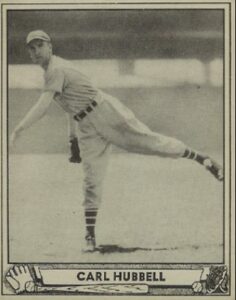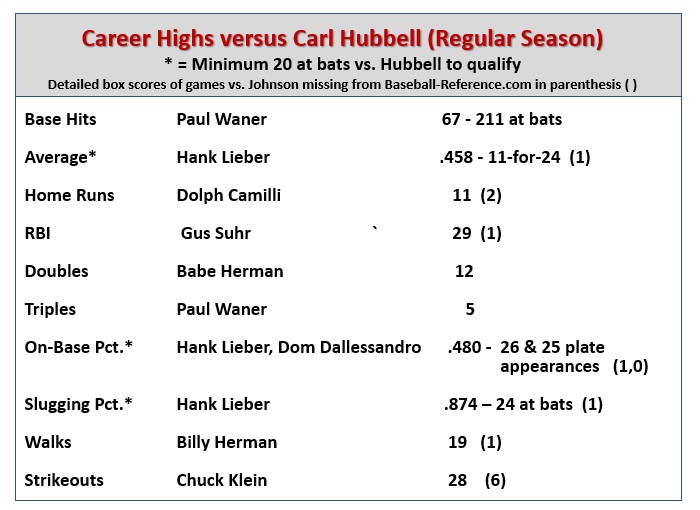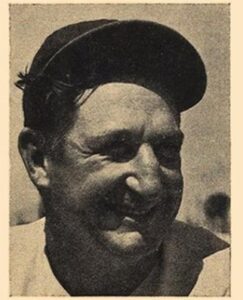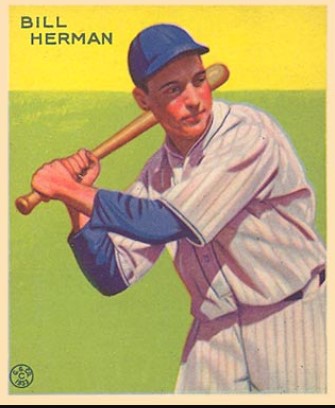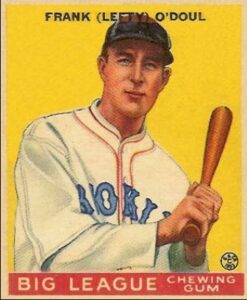Who’s Your Daddy – A Baseball Roundtable Series
Welcome to the 17th post in the Baseball Roundtable’s “Who’s Your Daddy?” series, where we take a look at Roundtable-selected lineups that performed exceptionally well against some of MLB’s greatest pitchers ever.
As always, I would stress that the pitchers included in the Who’s Your Daddy? series are among the “best in the business.” They are selected not because of the players who performed well against them, but rather because success among hitters when they were on the mound was the exception rather than the rule. We’ve looked at pitchers from a wide range of eras – from Bob Feller to Nolan Ryan to Justin Verlander. This time, we’re going back to Hall of Famer Carl Hubbell, who took the mound for the New York Giants from 1928 to 1943.
___________________________
Before we get started on this edition, here are links to the previous editions of this series. Please note: For still active pitchers, the stats are as they stood on the date of the post.
- Nolan Ryan, click here.
- Sandy Koufax, click here.
- Pedro Martinez, click here.
- Bob Gibson, click here.
- Randy Johnson, click here.
- Greg Maddux, click here.
- Justin Verlander, click here.
- Bob Feller, click here.
- Roger Clemens, click here.
- Max Scherzer, click here.
- Tom Seaver, click here.
- Mariano Rivera, click here.
- Warren Spahn, click here.
- Lefty Grove, click here.
- Steve Carlton, click here.
- Robin Roberts, click here.
If you go back through past editions of “Who’s Your Daddy?”, you may find a few surprises – like how Will Clark owned Nolan Ryan, Jerry Lynch‘s .714 average versus Sandy Koufax or Junior Spivey‘s six hits, one walk and one HBP in his first seven plate appearances versus Greg Maddux. There are a handful of surprises in the Hubbell addition as well, like:
- While Hubbell led the National League in strikeouts-to-walks ratio five times (each time fanning more than three times as many as he walked) and was in the top five a total of ten times, Billy Herman walked 19 times (versus nine whiffs) in his career against Hubbell;
- Ernie Lombardi fanned just four times in 126 plate appearance versus Hubbell;
- Hank Lieber – a .288 career hitter – was Hubbell’s teammate on the Giants in seven of Lieber’s ten MLB seasons. Lieber hit .458 versus Hubbell in the three seasons he faced him and, if you take out his at bats versus Hubbell, Lieber’s career average would be seven points lower.
- Lefty O’Doul – who hit .357 against Hubbell – faced nine Hall of Fame pitchers in his career and hit .375 against them.
Before getting into the lineup (and more tidbits), let’s look at why Carl Hubbell is a solid choice for this series.
Hubbell, known for his darting and baffling screwball, pitched in the major leagues for 16 seasons (1928-43) – all with the New York Giants. He made it to the major leagues – at the age of 25 – in July of 1928, in the middle of his fifth professional season. At the time, the 6’/170-pound southpaw was 12-9, 2.97 for the Class-A Beaumont Explorers. Hubbell’s progress while in the Tiger’s system was reportedly stymied by the belief that relying on the screwball (a “reverse-curve” that, at the time, was termed a fade-away) would be too hard on his arm to be sustained for any significant period of time. The Tigers sold Hubbell to Beaumont before the 1928 season, where – now set free to use his screwball extensively – he was spotted by a New York Giants’ scout. His contract was purchased by the Giants, he was quickly brought to the major-leagues and the rest, as they say, is history.
Hubbell pitched for the Giants for 16-seasons and earned the nicknames “King Carl” and “The Meal Ticket” – a well as a ticket to the Baseball Hall of Fame. Over that span, Hubbell was a nine-time All-Star, five-time 20-game winner and led the NL in earned run average three times, complete games once, innings pitched once, strikeouts once and strikeout-to-walk ratio five times. He was also selected as the National League’s Most Valuable Player twice (1933 & 1936).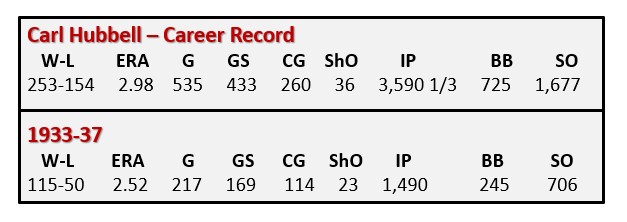
Hubbell pitched in five All Star Games, putting up a 2.79 ERA and fanning 11 batters in 9 2/3 innings. He also started six World Series games, going 4-2, 1.79, with four complete games. In the 1933 World Series, he started twice and pitched and won two complete games (one an 11-inning contest), giving up no earned runs (three unearned).
Carl Hubbell Makes All Star Game History
In the 1934 All Star Game (just the second AL/NL All Star Game), Carl Hubbell struck out six batters to set a single-game All Star record that has since been matched, but remains unbroken. And, Hubbell did it in grand – even legendary – fashion, fanning five future Hall of Famers in a row. After starting the game by giving up a single to AL 2B Charlie Gehringer and a walk to LF Heinie Manush, Hubbell fanned RF Babe Ruth, 1B Lou Gehrig and 3B Jimmie Foxx to get out of the inning. He then opened the second frame by fanning CF Al Simmons and SS Joe Cronin. After a Bill Dickey single, Hubbell fanned a sixth future Hall of Famer (pitcher Lefty Gomez).
How did those five future Hall of Fame position players do after Hubbell left the game? They went a combined seven-for-fifteen (four doubles), with two walks, six runs scored and four RBI.
So, there’s a look at King Carl, now let’s take a look at his Who’s Your Daddy? lineup. You should note that I evaluate these players not just on pure stats, but also on when those statistics were achieved (Hubbell for example was a much more dominant pitcher from 1928-1937 -winning an average of 19 games per season – then from 1938-43 (with an average of ten wins per season). And, as you saw in the earlier chart, he was particularly dominant from 1933-37. Here are the statistical leaders:
Why’d We Trade This Guy?
Outfielder Hank Lieber was a teammate of Hubbell’s on the Giants from 1933-38 – before being traded to the Cubs – and a teammate of Hubbell’s again in 1942 (after the Cubs traded him back to the Giants). While a Cub, Lieber faced Hubbell 26 times in seven games over three seasons. He collected 11 hits against Hubbell, including a double and three home runs. Among players with at least 20 at bats versus King Carl, Lieber had the highest batting average, highest on-base percentage; and highest slugging percentage. So, why didn’t he make the final “Who’s Your Daddy?” lineup – mainly because he did all this damage from 1939-1941, when Hubbell was 33-30, 3.36. Still Lieber deserves a shout out in this post. Lieber, by the way, was a pretty good ballplayer. In ten MLB seasons, he went .288-101-518 (813 games) and was a three-time All Star.
_______________________________________
Now for the lineup.
Catcher – Ernie Lombardi
Hall of Famer Ernie Lombardi faced Carl Hubbell in 42 games between 1931 and 1942, reaching him for a .331 average (25 points above Lombardi’s career average), with six homers (second-most against Hubbell by any batter) and 18 RBI (ninth-most). His 40 base hits were also the ninth-most against King Carl. In 1939, a season in which Hubbell went 11-9, 2.75, Lombardi went five-for-eight against him, with a double, a home run and five RBI in three games. Lombardi hit .400 or better versus Hubbell in five of the 11 seasons he faced him.
_________________________________
Ernie Lombardi caught both of Johnny Vander Meer’s consecutive no-hitters (June 11 & 15, 1938).
_______________________________
Ernie Lombardi struck out in his first plate appearance versus Carl Hubbell (April 27, 1931). He then went sixty-seven plates appearance against him before fanning again (July 26, 1936). In 126 career plate appearances versus Hubbell, Lombardi fanned just four times.
Lombardi played 17 MLB seasons (1931-47 … Robins, Reds, Braves, Giants). He was an eight-time All Star, the 1938 National League MVP and won two batting titles. Lombardi hit .300+ in ten seasons and under .280 just twice. Lombardi’s final stat line was .306-189, 890.
Note: I also looked at Al Todd, who hit .325-4-11 versus Hubbell over 32 games – but drew zero walks, while fanning 14 times. Todd played 11 MLB seasons (1932-41, 1943) and hit .276-35-366 in 863 games.
____________________________________________
First Base – Dolph Camilli
While Dolph Camilli hit just .279 ( about equal to his career .277 average) versus Hubbell (in 46 games), His 11 home runs versus Hubbell are far-and-away the most of any batter (the next highest is six) and his 25 RBI are second all-time against Hubbell. Note: Camilla’s 11 round trippers versus Hubbell are also the most Camilli hit against any pitcher.
__________________________________
After two seasons facing Hubbell (1933-34), Dolph Camilli was just 2-for-25 (.080), with no walks and six strikeouts versus The Meal Ticket. Then in 1935 – when Hubbell went 23-12, 3.27 – Camilli seem to figure something out, going 11-for-23 (.478) against Hubbell, with three home runs and six RBI (in seven games). Between 1935 and 1942, Camilla hit .400 or better against Hubbell in four seasons.
________________________________________
Camilli played 12 MLB seasons (1933-43, 1945 … Cubs, Phillies, Dodgers, Red Sox). He was a two-time All Star and, with the Dodgers in 1941, led the NL in home runs (34) and RBI (120), while hitting .285 and capturing the National League MVP Award. His final stat line was .277-239-950. He hit 20 or more home runs in eight seasons and drove in 100 or more runs in five.
Note: At first base, I also looked at Gus Suhr, who drove in 29 regular-season runs versus Hubbell (the most of any hitter). Suhr, however, hit only .255, with just two home runs against Hubbell. Suhr was a career .279-84-818 hitter (11 seasons … 1930-40).
_____________________________________________
Second Base – Billy Herman
Billy Herman (a career.304 hitter) hit .327, with a .399 on-base percentage in 53 games versus Carl Hubbell (1931-42). He hit .400 or better in four seasons against him and was particularly effective against Hubbell’s vaunted screwball in 1935 (when Hubbell went 23-12, 3.27). That season, Herman torched Hubbell for a .550 average (11-for-20), with three home runs and eight RBI in six games.
Hall of Famer Herman played 15 MLB seasons (1931-43, 1945-47 … Cubs, Dodgers, Braves, Pirates), hitting .304-47-839, with 1,163 runs scored. He was a ten-time All Star, and led his league in hits once, doubles once and triples once. Herman hit .325 or higher in five seasons and finished in the top-five in the MVP voting three times. His best season was with the 1935 Cubs, when he hit .341-7-83, scored 113 runs and led the league with 222 hits. 57 doubles and 24 sacrifice bunts.
Let’s Get This Party Started
Billy Herman shares the record(s) for the most base hits and most extra-base hits in an Opening Day game. On the Cubs’ Opening Day in 1936 (April 16 in St. Louis), Herman collected five hits (three doubles, a home run and a single) in five at bats, as the Cubs pounded the Redbirds 12-7.
Note: I also looked at Pete Coscarart at second base. Although he faced Carl Hubbell late in Hubbell’s career, the Dodgers’ 2B-SS got off to a good start against King Carl. In his first six plate appearances against Hubbell, Coscarart went single, single, single, strikeout, hit-by-pitch, single. In 14 games against Hubbell (1939-43), Coscarart (a career .243 hitter), hit .412 (14-for-34). In, putting Herman ahead of Coscarart, I considered Coscarart faced Hubbell over the final five years of Hubbell’s career and his 14 hits produced just one RBI (in eight games).
________________________________________
Third Base – Tie: Pepper Martin & Les Bell
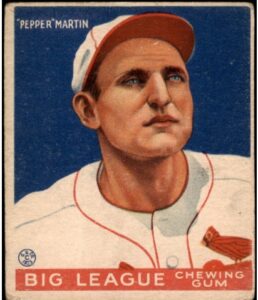 Pepper Martin – Cardinals’ spark plug Pepper Martin started against Carl Hubbell in LF, CF, RF and 3B – and makes it here at third base because he started more games (against Hubbell) there than at any other position. Martin’s 43 hits were the fifth-most against Hubbell, his eight doubles also fifth, his three triples tied for third, his four home runs tied for sixth and his 21 RBI tied for sixth. A career .298 hitter, Martin hit .327 versus Hubbell.
Pepper Martin – Cardinals’ spark plug Pepper Martin started against Carl Hubbell in LF, CF, RF and 3B – and makes it here at third base because he started more games (against Hubbell) there than at any other position. Martin’s 43 hits were the fifth-most against Hubbell, his eight doubles also fifth, his three triples tied for third, his four home runs tied for sixth and his 21 RBI tied for sixth. A career .298 hitter, Martin hit .327 versus Hubbell.
________________
Pepper Martin had five singles (and a strikeout) in his first six plate appearances versus Carl Hubbell.
__________________
Martin played 13 MLB seasons (1928, 1930-40, 1944), all for the Cardinals. He hit .298-59-501, with 146 steals and 756 runs scored in 1,189 games. He was a four-time All Star and led the NL in stolen bases three times. Martin hit .300 or better in six campaigns and scored 100+ runs three times (each time surpassing 120 runs scored). He played in 100 or more games in just five of his 13 MLB seasons.
Les Bell – Les Bell hit .385, with one home run and eight RBI in 11 games against Hubbell (1928-31) – including a pinch-hit Grand slam on May 26, 1929. His .429 on-base percentage against Hubbell was the seventh-best among player with at least 25 plate appearances against The Meal Ticket. Bell played in nine MLB seasons (1923-31 … Cardinals, Braves, Cubs), hitting .290-86-509 in 896 games. His best season was 1926, when he hit .325-17-100, for the Cardinals and finished sixth in the MVP voting.
_____________________________________
Shortstop – Arky Vaughn
Arky Vaughn had 52 hits in 54 games against Carl Hubbell (the second-most regular season safeties of any player). His four home runs tie for the sixth-most and his 16 RBI tie for fourteenth. Vaughn hit ,333 or better in five of the 11 seasons he faced Hubbell and he was particularly effective in 1937 (when Hubbell went 22-8, 3.20 and Vaughn hit .444, with two home runs against him in five games).
Vaughn played 14 MLB seasons (1932-43, 1947-48 … Pirates, Dodgers). The nine-time All Star hit .318-96-926, with 1,173 runs scored. He led the NL in runs scored three times, triples three times, steals once, batting average once and walks three times.
.300 … That’s a Nice Round Number
Arky Vaughn his .300 or better in each of his his first ten MLB seasons and in 12 of his 14 MLB campaigns.
____________________________________________
Outfield – Lefty O’Doul
Lefty O’Doul hit .357 against Carl Hubbell in 25 games, with five home runs (fifth-most against Hubbell) and 17 RBI (tied for tenth most). Surprisingly, O’Doul started his career as a pitcher. In fact, in 1921 – at the age of 24 – he went 25-9, 2.39 (pitching in 47 games) for the Pacific Coast League San Francisco Seals and, in 1924, he appeared on the mound in 23 games for the Red Sox. Note: This does not mean his bat was silent. In that 25-win season for the Seals, he also hit .338 (in 74 games). Ultimately, a sore arm led him off the mound and to a career .349 MLB average.
In 1929, Left O’Doul hit .520 (13 for 25) with three home runs and seven RBI against Carl Hubbell (in six games).
O’Doul played 11 MLB seasons (1919-20, 1922-23 and 1928-34 … Yankees, Red Sox, Giants, Phillies, Dodgers). He was a career .349 hitter and twice led the NL in average (.398 in 1929 for the Phillies and .368 in 1932 for the Dodgers). O’Doul’s career stat line was .349-113-542 (in 970 games).
Lefty O’Doul Liked to Face the Best
Available stats show that in 360 at bats against nine Hall of Fame pitchers, O’Doul hit .375, with 16 home runs and 70 RBI (with 37 walks versus just 16 strikeouts).
_________________________________________
Outfield – Hack Wilson
Hack Wilson hit .351 against Carl Hubbell in 33 games. His four home runs is tied for the sixth-most against Hubbell, his 17 RBI tied for tenth, his .427 on-base percentage tenth and his .575 slugging percentage eleventh. Wilson also drew 14 walks against Hubbell, the third-most of any player. Wilson hit .333 or better in six of the seven seasons he faced Hubbell (1928-34). Of note, in the one season he failed to it at least .333 against King Carl, Hubbell held Wilson hitless in ten at bats.
In 1933, when Hubbell went 23-12, with an MLB-low 1.66 earned run average, Wilson hit .476 against him in seven games.
_________________
Hack Wilson holds the single-season MLB record for RBI. He put up a .356-56-191 line for the 1930 Cubs.
_____________________
A Hall of Famer, Wilson played 12 MLB seasons (1923-34 … Giants, Cubs, Dodgers, Phillies). He led the NL in home runs four times – a high of 56 in 1930 – RBI twice and walks twice. He hit over .300 in five seasons and his career stat line was .307-244-1.063.
____________________________________________
Outfield – Tie …. Joe Medwick and Ival Goodall
For the third outfield spot, we have a tie between a name you’ve heard a lot – and another you might not be familiar with. I’d add that filling this final spot was no easy call.
Joe Medwick … Joe “Ducky” Medwick hit .313 versus Hubbell in 47 games. His 50 hits versus King Carl are tied for fourth-most all-time, his six home runs tied for second, his nine doubles tied for third and his 22 RBI are fourth, So, why was this a difficult call? (This should provide more insight into how I select these lineups.)
- Medwick’s .313 average was below his ,324 career mark.
- His on-base percentage (.325) against Hubbell was only 12 points above his average.
- Medwick really padded his stats against Hubbell in the final two year he faced him (which were two of Hubbell’s final three campaigns). Medwick, who faced Hubbell in ten seasons, hit .480 against him in those two campaigns– collecting 24 percent of his career hits versus Hubbell and 31 percent of his career RBI.
- Balancing all this was the fact the Medwick hit .365 (19-for-52), with two home runs and six RBI in 1936-37 – two seasons in which Hubbell posted a combined 48-14, 2.71 mark.
Medwick, a Hall of Famer, played 17 MLB seasons hitting .324-205-1,383. He led the league in runs scored once, hits twice, doubles three times, triples once, home runs once, RBI three times, total bases three times and batting average once. He was a ten-time All Star and the 1937 National Leaguer MVP (when he won the Triple Crown).
Ival Goodman … A bit less well-known than Ducky Medwick (understatement there), Ival Goodman played in just 25 games versus Hubbell (64 at bats), but his six homers tied for the second-most against Hubbell and his 16 RBI were 14th and, notably, everyone ahead of him on the lists in those two categories had at least 49 percent more at bats versus Hubbell. Goodman’s .328 average versus Hubbell was more than 40 points higher than his career averages (.281).
_______________________________
Ival Goodman’s first hit off Carl Hubbell (in his first game against him) was an inside-the-park home run – the only inside-the-park homer of Goodman’s MLB career.
__________________________
Goodman played in 11 MLB seasons (1935-44 … Reds Cubs), hitting .281-95-515 in 1,107 games. He was a two-time All Star and twice led the National League in triples. His best season was 1938, when he went .292-30-92 for the Reds.
Goodman played football, basketball and track in high school (his high school did not field a baseball team) and was recruited off a townball team. He was known more for his speed and defense than his power (he had 85 career triples and 95 career home runs). Over his career, Goodman averaged one home run per every 46.7 at bats – against Hubbell he laced one home per every 10.6 at bats.
Ival Goodman drove in the first run in the first night game in MLB history. It came in the bottom of the first frame of a Reds 2-1 win over the Phillies on May 22, 1935.
Note: I also looked at Paul Waner (.318-0-24), whose 67 hits were the most of any batter versus Hubbell (Waner’s .318 average was below his career average and there were those zero home runs) and Jack Rothrock (.350-2-9 in 11 games versus Hubbell).
Pitcher(s) – Harry Gumbert, Jim Tobin, Fred Frankhouse and Red Lucas
For obvious reasons, individual opposing pitchers did not rack up significant numbers of plate appearances versus Hubbell. With that disclaimer, here are a few who hit him well.
Harry Gumbert … Righty Harry Gumbert was a career .184 hitter (with five home runs and 45 RBI) in 708 at bats. However, he hit .600 (in three games) versus Carl Hubbell. As a pitcher, Gumbert went 143-13 over 15 MLB seasons (1935-44, 1946-50 … Giants, Cardinals, Reds, Pirates). He appeared in 508 games (235 starts). Gumbert’s best season as a hitter was 1941, when he .292 (17-for-64), with two home runs and six RBI (for the Giants and Cardinals). His best season on the mound was 1937, when he went 18-11, 4.32 for the Giants (as a teammate of Hubbell). Gumbert won ten or more games in eleven seasons. In the three games in which he pitched and batted against Hubbell, Gumbert went 2-1, 2.53, while Hubbell went 101, 3.92.
________________________________________
Jim Tobin … No surprise to find right-hander Jim Tobin here. He was one of the best-hitting pitchers of all-time (in fact, appearing as a pinch-hitter 108 times). Tobin played in the major leagues from 1937 through 1945 (Pirates, Braves, Tigers). At the plate, his career stat line was .230-17-102 (in 796 at bats). As a pitcher, he went 105-112, 3.44 in 287 games (227 starts). As a moundsman, Tobin finished over .500 in just three of nine seasons. His best season as a batsman was his 1937 rookie campaign, when he hit .441 (15-for-34) in 21 games. (He had a five-homer, 17-RBI season in 1945 (his final MLB season), but hit just .137. In the games in which Tobin both pitched and batted against Hubbell (he was used as a pinch hitter versus Hubbell twice), Tobin went 2-1, with a 1.70 earned run average to Hubbell’s 2-2, 1.68.
Jim Tobin is one of only two MLB pitchers to hit three home runs in a game. On May 13, 1942 – in a 6-5 Braves’ win over the Cubs – Tobin pitched a complete-game five-hitter (three earned runs) for the Braves and smacked three home runs (four RBI). Pitcher Guy Hecker hit three home runs for the Louisville Colonels in a 22-5 win over the Baltimore Orioles on August 15, 1886.
________________________________________
Fred Frankhouse … Righty Fred Frankhouse was a solid hitter (for a pitcher), putting up a .208 career average (132-for-636), with one homer and 58 RBI – and hitting .357 versus Carl Hubbell. He played 13 MLB seasons (1927-39 … Cardinals, Braves, Dodgers) and went 106-97, 3.92 in 402 games (213 starts). His best season season was 1934 – his only All Star year – when he went 17-9, 3.20 for the Braves. He won ten or more games in five seasons(1933-36). His best season at the plate was 1930, when he hi t.359, with seven RBI in 27 games. In games in which he pitched and batted against Hubbell, Frankhouse had some “hard luck,.” He was 1-4, with a 1.98 earned run average to Hubbell’s 5-1, 2.39.
Hard Luck
On April 20, 1933, Frank Frankhouse pitched a complete game for the Braves (versus Carl Hubbell and the Giants), giving up just one earned run. Hubbell, however, pitched a four-hit, 13-strikeout shutout. Frankhouse, by the way, had two of the four hits versus Hubbell.
In the first three games that Frankhouse pitched versus Hubbell, Frankhouse surrendered just four earned runs in 26 innings, while Hubbell gave up just two earned tallies in 28 innings (one was a 10-inning contest). For his quality efforts, Frankhouse picked up three losses.
________________________________________
Red Lucas … Left-handed hitting (right-handed pitching) Red Lucas is probably on a lot of lists like this – having made 396 appearances as a pitcher and 506 as a pinch-hitter. At the plate, Lucas hit .281 (404-for-1,439), with three home runs and 190 RBI. (He hit .318 versus Hubbell.) On the mound, Lucas was 157-135, 3.72 in 396 games (303 starts/204 complete games/22 shutouts). His best season on the bump was 1929 (Reds), when he went 19-12, 3.60 and led the NL with 28 complete games. Lucas won 15 or more games three times and led the NL in complete games three times. His best season with the bat was 1927, when he hit .313 (47-for-150) and drove in 28 runs. Lucas hit .300 or better in six of his 16 seasons. In games in which he pitched against Hubbell (Lucas was never used as a pinch hitter versus King Carl), Lucas held his own. He went 4-6, 3.10 to Hubbell’s 5-4, 2.97.
Primary Resources: Baseball-Reference.com
Baseball Roundtable … blogging baseball since 2012.
 Baseball Roundtable is on the Feedspot list of the Top 100 Baseball Blogs. To see the full list, click here.
Baseball Roundtable is on the Feedspot list of the Top 100 Baseball Blogs. To see the full list, click here.
I tweet (on X) baseball @DavidBaseballRT
Follow Baseball Roundtable’s Facebook Page here. More baseball commentary; blog post notifications.
Member: Society for American Baseball Research (SABR); The Baseball Reliquary; The Negro Leagues Baseball Museum.
